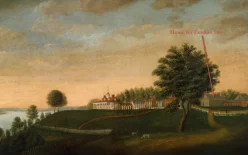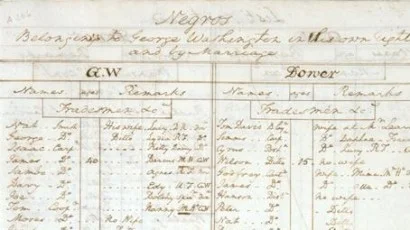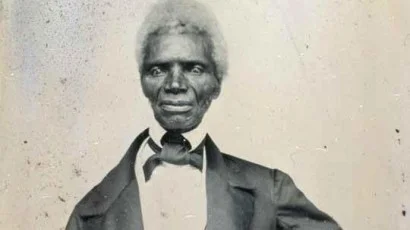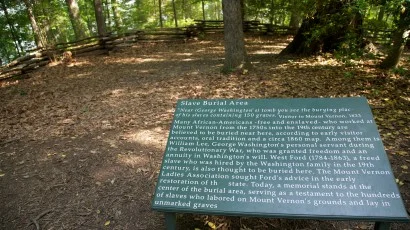
George Washington's views on the subject of slavery shifted over the course of his life. Washington grew up in a society that reinforced the notion that slavery was both right and natural. His parents and neighbors enslaved those of African descent. By the time of Washington's birth, slavery was an ingrained aspect of Virginia life for nearly a century and an indispensable part of the economic, social, legal, cultural, and political fabric of the colony. When George Washington took control of the Mount Vernon property in 1754, the population of Fairfax County was around 6,500 people, of whom a little more than 1,800 or about 28% were enslaved. The proportion of enslaved people as a whole rose throughout the century. By the end of the American Revolution, over 40% of the people living in Fairfax County were enslaved.1
Early Experiences
George Washington’s first inherited enslaved people, when his father died and left him the 280-acre farm near Fredericksburg, Virginia where the family was then living. Washington was willed ten enslaved people, and later in the division of his estate inherited eleven enslaved people. As a young adult, Washington purchased at least eight more enslaved people, including a carpenter named Kitt who was acquired for £39.5. Washington purchased more enslaved people in 1755, four other men, two women, and a child.
It was after his marriage to Martha Dandridge Custis in January of 1759 that Washington's slaveholdings increased dramatically. His young bride was the widow of a wealthy planter, Daniel Parke Custis, who died without a will in 1757. Her share of the Custis estate brought another eighty-four enslaved people to Mount Vernon. In the sixteen years between his marriage and the beginning of the American Revolution, Washington acquired more than 40 additional enslaved people through purchase.2 Most of the subsequent increase in the enslaved population at Mount Vernon occurred as a result of the large number of children born on the estate to enslaved parents.
Washington and Slaveholding
Various sources offer differing insight into Washington's behavior as he began to purchase more enslaved people. Richard Parkinson, an Englishman who lived near Mount Vernon, once reported that "it was the sense of all his [Washington's] neighbors that he treated [his slaves] with more severity than any other man."3 Conversely, a foreign visitor traveling in America once recorded that George Washington treated those that he enslaved "far more humanely than do his fellow citizens of Virginia." Washington himself once criticized other large plantation owners, "who are not always as kind, and as attentive to their [the slaves'] wants and usage as they ought to be."4
Washington directed the close supervision of those he enslaved by farm managers and overseers. When away from Mount Vernon, he requested frequent updates about agricultural matters and those he enslaved. This included information about work assignments for enslaved people, health updates, and punishments for resistance.
Toward the end of his life, he looked back on his role enslaving others, reflecting that: "The unfortunate condition of the persons, whose labour in part I employed, has been the only unavoidable subject of regret. To make the Adults among them as easy & as comfortable in their circumstances as their actual state of ignorance & improvidence would admit; & to lay a foundation to prepare the rising generation for a destiny different from that in which they were born; afforded some satisfaction to my mind, & could not I hoped be displeasing to the justice of the Creator."5 However, despite these sentiments, he continued to pursue those he enslaved that ran away.
Changing Views on Slavery
Over the course of Washington's life, he gradually changed from a young man who accepted slavery as matter of course, into a person who decided never again to buy or sell another enslaved person. In personal writings, he held hopes for the eventual abolition of the institution. Probably the biggest factor in the evolution of these views was the Revolutionary War. During the conflict, his views on slavery were radically altered. Within three years of the start of the war, Washington, who was then forty-six years old and had owned enslaved people for thirty-five years, confided to a cousin that he longed "every day...more and more to get clear" of the ownership of enslaved people.6
During the war Washington traveled to parts of the country where agriculture was undertaken without the use of enslaved labor. He also witnessed Black soldiers in action, fighting bravely in the Continental Army. Within seven months of taking command of the army, Washington approved the enlistment of free black soldiers, which he and the other general officers had originally opposed.7
It was also during the war that Washington was first exposed to the views of the Marquis de Lafayette, who ardently opposed slavery. During the period between the end of the war and the start of his presidency, abolitionists began approaching Washington, seeking his support for their cause. Over and over again, he responded with his conviction that the best way to affect the elimination of slavery was through the legislature. He hoped that this would set up a program of gradual emancipation, and for which he would gladly give his vote.
As he wrote to his friend Robert Morris in 1786, Washington hoped that no one would read his opposition to the methods of certain abolitionists, in this case the Quakers, as opposition to abolition as a concept: "I hope it will not be conceived from these observations, that it is my wish to hold the unhappy people, who are the subject of this letter, in slavery. I can only say that there is not a man living who wishes more sincerely than I do, to see a plan adopted for the abolition of it; but there is only one proper and effectual mode by which it can be accomplished, and that is by Legislative authority; and this, as far as my suffrage will go, shall never be wanting."8 Some parts of the United States passed plans for gradual abolition, such as Pennsylvania. While serving as president in Philadelphia, Washington circumvented these measures by regularly transporting his enslaved workers to Mount Vernon to ensure they would not be freed by the measure.
Washington admitted to Lafayette, however, that he "despaired" of seeing an abolitionist spirit sweep the country. He confided to the younger man in 1786 that "some petitions were presented to the Assembly at its last Session, for the abolition of slavery, but they could scarcely obtain a reading. To set them [the slaves] afloat at once would, I really believe, be productive of much inconvenience & mischief; but by degrees it certainly might, & assuredly ought to be effected & that too by Legislative authority."9

George Washington's Will
While he never publicly led the effort to abolish slavery, Washington did try to lead by setting an example. In his will, written several months before his death in December 1799, Washington left directions for the emancipation after Martha Washington's death, of all the enslaved people who belonged to him. Washington was not the only Virginian to free those they enslaved at this period. Toward the end of the American Revolution, in 1782, the Virginia legislature made it legal for slaveholders to manumit those they enslaved, without a special action of the governor and council, which had been necessary before.
Of the 317 enslaved people at Mount Vernon in 1799, a little less than half, 123 individuals, belonged to George Washington and were set free under the terms of his will. When Martha Washington's first husband, Daniel Parke Custis, died without a will, she received a life interest in one-third of his estate, including those he enslaved. The other two-thirds of the estate went to their children. Neither George nor Martha Washington could free them by law and, upon her death they reverted to the Custis estate and were divided among her grandchildren. By 1799, 153 slaves at Mount Vernon were part of this dower property.
In accordance with state law, George Washington stipulated in his will that enslaved people who were elderly or too sick to work were to be supported throughout their lives by his estate. Children without parents, or those whose families were too poor were to be bound out to someone who would teach them reading, writing, and a useful trade, until they were ultimately freed at the age of twenty-five.10
In December 1800, Martha Washington signed a deed of manumission for those enslaved by her deceased husband, a transaction which is recorded in the abstracts of the Fairfax County, Virginia, Court Records. They would finally receive their freedom on January 1, 1801.11
Mary V. Thompson Research Historian Mount Vernon Estate and Gardens
Notes:
1. Donald M. Sweig, "Slavery in Fairfax County, Virginia, 1750-1860: A Research Report," (Fairfax County, Virginia: History and Archaeology Section, Office of Comprehensive Planning, June 1983), 4, 8, 15.
2. Wills of George Washington and His Immediate Ancestors, ed. Worthington Chauncey Ford (Brooklyn, New York: Historical Printing Club, 1891), 42 and 42n; Worthington Chauncey Ford, Washington as an Employer and Importer of Labor (Brooklyn, New York: Privately Printed, 1889); "Worthy Partner": The Papers of Martha Washington, ed. Joseph E. Fields (Westport, Connecticut and London: Greenwood Press, 1994), 105-107.
3. Richard Parkinson, A Tour in America, in 1798, 1799, and 1800 (London: Printed for J. Harding and J. Murray, 1805), 420.
4. "George Washington to Arthur Young, 18 June - 21 June 1792," ed. John C. Fitzpatrick, The Writings of George Washington from the Original Manuscript Sources 1745-1799, Vol. 32 (Washington, D.C.: United States Government Printing Office, 1931), 65.
5. David Humphreys, Life of George Washington with George Washington's Remarks, ed. Rosemarie Zagarri (Athens: University of Georgia Press, 1991), 78.
6. "George Washington to Lund Washington, 15 August 1778," The Writings of George Washington, Vol. 12, 327.
7. George Washington, "General Orders, 31 October 1775 and 12 November 1775," The Writings of George Washington, Vol. 4, 57 & 86. See also The Writings of George Washington, Vol. 4, 8n.
8. "George Washington to Robert Morris, 12 April 1786."
9. "George Washington to the Marquis de Lafayette, 10 May 1786," The Papers of George Washington, Confederation Series, Vol. 4, 43-4.
10. The Statutes at Large; Being a Collection of All the Laws of Virginia, From the First Session of the Legislature, in the Year 1619, Vol. 6, ed. William Waller Hening (Richmond, Virginia: Printed for the editor at the Franklin Press, 1819), 112, and Vol. 11 (Richmond, Virginia: Printed for the editor by George Cochran, 1823), 39-40.
11. The Last Will and Testament of George Washington and the Schedule of Property: to which is appended the last will and testament of Martha Washington. 6th ed. rev., ed. John C. Fitzpatrick (Mount Vernon, VA : Mount Vernon Ladies' Association of the Union, 1992), 2-4. For Virginia laws dealing with the estate issues and manumission requirements faced by the Washingtons, see The Statutes at Large, Volume V, ed. William Waller Hening (Richmond, Virginia: Printed for the editor at the Franklin Press, 1819), 445, 446, and 464; Volume XI (Richmond, Virginia: Printed for the editor by George Cochran, 1823), 29-40; Volume XII (Richmond, Virginia: Printed for the editor by George Cochran, 1823), 145, 146, and 150.
Bibliography:
MacLeod, Jessie, Mary V. Thompson. Lives Bound Together: Slavery at George Washington’s Mount Vernon, Mount Version Ladies Association, 2016.
Morgan, Philip D. “‘To Get Quit of Negroes’: George Washington and Slavery.” Journal of American Studies, 39, no. 3 (December 2005): 403-29.
Schoelwer, Susan P., ed. Lives Bound Together: Slavery at George Washington's Mount Vernon. Mount Vernon, VA: Mount Vernon Ladies Association, 2016.
Thompson, Mary V. “The Only Unavoidable Subject of Regret”: George Washington, Slavery, and the Enslaved Community at Mount Vernon. Charlottesville and London: University of Virginia Press, 2019.

Learn More
The Digital Encyclopedia of George Washington invites readers to explore a variety of topics related to slavery, enslaved persons, and Washington's land. Use this link to find a list of entries pertaining to enslaved individuals, their lives and experiences, and the plantations where they worked.




